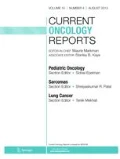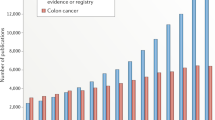Abstract
Along with the increasing adoption of electronic health records (EHRs) are expectations that data collected within EHRs will be readily available for outcomes and comparative effectiveness research. Yet the ability to effectively share and reuse data depends on implementing and configuring EHRs with these goals in mind from the beginning. Data sharing and integration must be planned both locally as well as nationally. The rich data transmission and semantic infrastructure developed by the National Cancer Institute (NCI) for research provides an excellent example of moving beyond paper-based paradigms and exploiting the power of semantically robust, network-based systems, and engaging both domain and informatics expertise. Similar efforts are required to address current challenges in sharing EHR data.
Similar content being viewed by others
References
Papers of particular interest, published recently, have been highlighted as: • Of importance
Committee on a Framework for Development a New Taxonomy of Disease, National Research Council. Toward Precision Medicine: Building a Knowledge Network for Biomedical Research and a New Taxonomy of Disease. The National Academies Press; 2011. Available at http://www.nap.edu/openbook.php?record_id=13284. Accessed July 2012.
Grossman C, Powers B, McGinnis JM. Digital Infrastructure for the Learning Health System: The Foundation for Continuous Improvement in Health and Health Care: Workshop Series Summary. Institute of Medicine; 2011.
Sioutos N, de Coronado S, Haber MW, Hartel FW, Shaiu W-L, Wright LW. NCI Thesaurus: a semantic model integrating cancer-related clinical and molecular information. J Biomed Inform. 2007;40(1):30–43.
Ohmann C, Kuchinke W. Future Developments of Medical Informatics from the Viewpoint of Networked Clinical Research. Methods Inf Med. 2009;48(1):45–54.
Dean BB, Lam J, Natoli JL, Butler Q, Aguilar D, Nordyke RJ. Review: use of electronic medical records for health outcomes research. Med Care Res Rev. 2009;66(6):611–38.
Abernethy AP, Etheredge LM, Ganz PA, Wallace P, German RR, Neti C, et al. Rapid-learning system for cancer care. J Clin Oncol. 2010;28(27):4268–74.
Holve E, Segal C, Lopez MH, Rein A, Johnson BH. The Electronic Data Methods (EDM) Forum for Comparative Effectiveness Research (CER). Medical Care [Internet]. 2012;50. Available from: http://journals.lww.com/lww-medicalcare/Fulltext/2012/07001/The_Electronic_Data_Methods__EDM__Forum_for.5.aspx. Accessed July 2012.
• Kanas G, Morimoto L, Mowat F, O’Malley C, Fryzek J, Nordyke R. Use of electronic medical records in oncology outcomes research. Clinicoecon Outcomes Res. 2010;2:1–14. This article discusses in depth the challenges to using EHR data in oncology, and includes a useful table on the advantages and disadvantages of a number of datasets used for outcomes research.
• Pathak J, Wang J, Kashyap S, Basford M, Li R, Masys DR, et al. Mapping clinical phenotype data elements to standardized metadata repositories and controlled terminologies: the eMERGE Network experience. J Am Med Inform Assoc. 2011;18(4):376–86. This article describes in depth the process of using Common Data Elements to enable the integration and analysis of phenotypic data collected at multiple institutions as part of the Electronic Medical Records and Genomics (eMERGE) project; a project with the aim of correlating whole genome scans with phenotype data extracted from electronic health records.
Kho AN, Pacheco JA, Peissig PL, Rasmussen L, Newton KM, Weston N, et al. Electronic Medical Records for Genetic Research: results of the eMERGE consortium. Sci Transl Med. 2011;3(79):79re1.
• Ochs MF, Casagrande JT, Davuluri RV. Biomedical informatics for cancer research. New York: Springer; 2010. The first nine chapters of this recently published book provide in-depth coverage of the technologies and techniques discussed in this paper. The final eleven chapters discuss software tools relevant to the cancer research community.
Landgrebe J, Smith B. The HL7 Approach to Semantic Interoperability. Presented at the International Conference on Biomedical Ontology. Buffalo, New York. Available at http://ontology.buffalo.edu/smith/articles/HL7-SAIF.pdf. Accessed July 2012.
Standards & Interoperability (S&I) Framework. Available at http://wiki.siframework.org/. Accessed July 2012.
Patel A, Kajdacsy-Balla A, Berman J, Bosland M, Datta M, Dhir R, et al. The development of common data elements for a multi-institute prostate cancer tissue bank: The Cooperative Prostate Cancer Tissue Resource (CPCTR) experience. BMC Cancer. 2005;5(1):108.
NCI Center for Biomedical Informatics and Information Technology. Cancer Data Standards Registry and Repository (caDSR). Available at https://cabig.nci.nih.gov/community/concepts/caDSR/. Accessed July 2012.
CDISC. Available at http://www.cdisc.org/. Accessed July 2012.
A Growable Network Information System (AGNIS). Available at http://www.agnis.net/. Accessed July 2012.
Center for International Blood & Marrow Transplant Research (CIBMTR) [Internet]. Available at http://www.cibmtr.org/pages/index.aspx. Accessed July 2012.
caBIG. Available at https://cabig.nci.nih.gov/. Accessed June 2012.
Beck JR, caBIG Strategic Planning Workspace. The Cancer Biomedical Informatics Grid(TM): Infrastructure and applications for a worldwide research community. Medinfo 2007: Proceedings of the 12th World Congress on Health (Medical) Informatics; Building Sustainable Health Systems: 2007. 2007;330–334.
Christensen T, Grimsmo A. Instant availability of patient records, but diminished availability of patient information: a multi-method study of GP’s use of electronic patient records. BMC Med Inform Decis Making. 2008;8(1):12.
Kashner TM. Agreement between administrative files and written medical records: a case of the Department of Veterans Affairs. Med Care. 1998;36(9):1324–36.
Rhodes ET, Laffel LMB, Gonzalez TV, Ludwig DS. Accuracy of administrative coding for type 2 diabetes in children, adolescents, and young adults. Diabetes Care. 2007;30(9):e99.
Leibson CL, Needleman J, Buerhaus P, Heit JA, Melton 3rd LJ, Naessens JM, et al. Identifying in-hospital venous thromboembolism (VTE): a comparison of claims-based approaches with the Rochester Epidemiology Project VTE cohort. Med Care. 2008;46(2):127–32.
Nadkarni PM, Ohno-Machado L, Chapman WW. Natural language processing: an introduction. J Am Med Inform Assoc. 2011;18(5):544–51.
Warner JL, Anick P, Hong P, Xue N. Natural language processing and the oncologic history: is there a match? J Oncol Pract. 2011;7(4):e15–9.
Zheng K, Mei Q, Hanauer DA. Collaborative search in electronic health records. J Am Med Inform Assoc. 2011;18(3):282–91.
Rosenbloom ST, Denny JC, Xu H, Lorenzi N, Stead WW, Johnson KB. Data from clinical notes: a perspective on the tension between structure and flexible documentation. J Am Med Inform Assoc. 2011;18(2):181–6.
Linder JA, Schnipper JL, Middleton B. Method of electronic health record documentation and quality of primary care. J Am Med Inform Assoc. 2012. Available at http://jamia.bmj.com/content/early/2012/05/19/amiajnl-2011-000788.abstract. Accessed July 2012.
Parsons A, McCullough C, Wang J, Shih S. Validity of electronic health record-derived quality measurement for performance monitoring. J Am Med Inform Assoc: JAMIA. 2012; Available at http://jamia.bmj.com/content/early/2012/02/08/amiajnl-2011-000557.long. Accessed July 2012.
Hoff T. Deskilling and adaptation among primary care physicians using two work innovations. Health Care Manag Rev. 2011;36(4):338–48.
Zheng K, Hanauer DA, Padman R, Johnson MP, Hussain AA, Ye W, et al. Handling anticipated exceptions in clinical care: investigating clinician use of “exit strategies” in an electronic health records system. J Am Med Inform Assoc. 2011;18(6):883–9.
Freudenheim, M. Digitizing Health Records Before It Was Cool. New York Times. January 14, 2012. Available at http://www.nytimes.com/2012/01/15/business/epic-systems-digitizing-health-records-before-it-was-cool.html?_r=1&pagewanted=all. Accessed June 2012.
Lanham HJ, Leykum LK, McDaniel RR. Same organization, same electronic health records (EHRs) system, different use: exploring the linkage between practice member communication patterns and EHR use patterns in an ambulatory care setting. J Am Med Inform Assoc. 2012;19(3):382–91.
Institute of Medicine. Informatics Needs and Challenges in Cancer Research: A Workshop. 2012. Available at http://www.iom.edu/Activities/Disease/NCPF/2012-FEB-27.aspx. Accessed June 2012.
George A. Komatsoulis. Program Announcement — caBIG. 2012. Available at https://cabig.nci.nih.gov/program_announcement. Accessed July 2012.
Harold Varmus. Announcement: New National Cancer Informatics Program (NCIP) — caBIG. 2012. Available at https://cabig.nci.nih.gov/ncip_announcement/. Accessed July 2012.
President’s Council of Advisors on Science and Technology. Realizing the Full Potential of Health Information Technology to Improve Healthcare for Americans: The Path Forward. Washington, DC: Executive Office of the President; 2010. Available at http://www.whitehouse.gov/sites/default/files/microsites/ostp/pcast-health-it-report.pdf. Accessed July 2012.
Chen D, Doumeingts G, Vernadat F. Architectures for enterprise integration and interoperability: past, present and future. Comput Ind. 2008;59(7):647–59.
Institute of Medicine (US) Committee on Comparative Effective Research. Initial national priorities for comparative effectiveness research. National Academies Press; 2009.
Sox HC, Greenfield S. Comparative effectiveness research: a report from the Institute of Medicine. Ann Intern Med. 2009;151(3):203–5.
Healthcare Information and Management Systems Society - HIMSS. Available at http://www.himss.org/ASP/index.asp. Accessed July 2012.
Blumenthal D, Tavenner M. The “meaningful use” regulation for electronic health records. N Engl J Med. 2010;363(6):501–4.
Foundation for Health Services Research. Health Outcomes Research: A Primer. Washington, DC: Foundation for Health Services Research; 1994 p. 10. Available at http://www.academyhealth.org/files/publications/healthoutcomes.pdf. Accessed July 2012.
Acknowledgments
This project was supported (in part) by the National Institutes of Health through the University of Michigan’s Cancer Center Support Grant (5 P30 CA46592), and by the National Center for Research Resources (Award Number UL1RR024986). The content is solely the responsibility of the authors and does not necessarily represent the official views of the National Institutes of Health or the National Center for Research Resources.
Disclosure
No potential conflicts of interest relevant to this article were reported.
Author information
Authors and Affiliations
Corresponding author
Appendix: Definitions
Appendix: Definitions
caDSR is a cancer-specific set of common data elements and the metadata for cancer research developed through the caBIG project. Examples include preferred terms, definitions, mapping to reference coding systems etc. [15, 19, 20].
Common Data Elements (CDEs) are data elements and annotations defined as standards across research or clinical projects. CDEs and relationships with other data elements are typically maintained in a metadata repository. Effective CDEs are typically developed by multi-disciplinary groups and validated in successive rounds of critical analysis [14].
Comparative effectiveness research (CER) is the generation and synthesis of evidence that compares the benefits and harms of alternative methods to prevent, diagnose, treat and monitor a clinical condition, or to improve the delivery of care. CER aims to answer questions such as “What works best, for whom, and under what conditions?” [40, 41].
Data sharing refers to the set of technologies, standards, regulations, and trust factors that make data collected for one purpose electronically available for other purposes. Data reuse and secondary use of data are often used synonymously with data sharing.
Electronic health records (EHRs) are longitudinal electronic records of patients’ health information, generated by one or more encounters in any care delivery setting, and commonly include patient demographics, progress notes, problems, medications, vital signs, past medical history, immunizations, laboratory data and radiology reports [42].
Meaningful use (MU) refers to the Centers for Medicare and Medicaid Services (CMS) program that provides a financial incentive for the “meaningful use” of certified EHR technology. The American Recovery and Reinvestment Act of 2009 specifies three main components: (a) use of a certified EHR in a meaningful manner; (b) use of certified EHR technology for electronic exchange of health information; and (c) use of certified EHR technology to submit clinical quality and other measures [43].
Outcomes research encompasses a set of methodologies long used by the health services research community to study aspects of health care delivery [44]. Outcomes and effectiveness research are facilitated by the integration of large-scale, multi-institutional data from EHRs, clinical trial management systems, pharmacy, radiology, and disease registries such as SEER.
Structured data refers to data that are organized into a structure such as fixed fields, and often stored in a structured database organized by columns and rows. Structured data are often coded according to some agreed upon coding system such as ICD-9, SNOMED-CT, or AJCC TNM standards for coding tumor stage. Coded structured data are can be made available for data sharing through a variety of interfaces including Web browsers, database query languages, application-specific interfaces, or data exchange formats.
Unstructured data refers to data such as free text that is not captured and stored in fixed fields, and not readily stored in rows and columns in databases. EHR documents such as physician notes and discharge summaries are largely composed of unstructured data. Increasingly, computer assisted techniques such as natural language processing (NLP) are being used to convert unstructured data to structured data—greatly reducing the need for manual chart review and subsequent data entry to convert unstructured to structured data.
Rights and permissions
About this article
Cite this article
Manion, F.J., Harris, M.R., Buyuktur, A.G. et al. Leveraging EHR Data for Outcomes and Comparative Effectiveness Research in Oncology. Curr Oncol Rep 14, 494–501 (2012). https://doi.org/10.1007/s11912-012-0272-6
Published:
Issue Date:
DOI: https://doi.org/10.1007/s11912-012-0272-6




